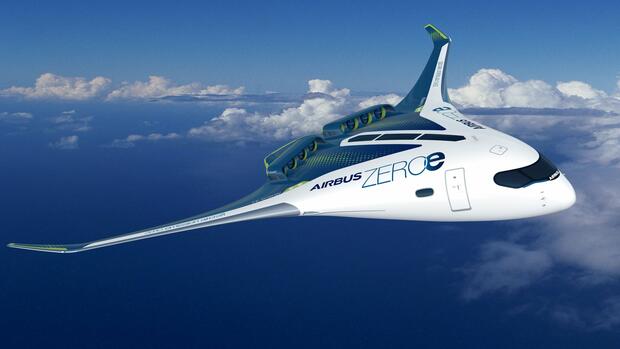When it comes to new propulsion systems such as hydrogen, the aircraft must be completely rethought. Artificial intelligence can help here.
(Photo: Airbus)
Frankfurt Airplane manufacturers are currently facing a major problem. They fail to deliver new aircraft on time. The commissioning of the Boeing 777X had to be postponed by five years, also because there were repeated problems with parts and materials.
The Airbus A350 was originally scheduled to make its maiden flight in 2009, but the jet was first delivered at the end of 2014. The development of aircraft with completely new engines such as hydrogen is likely to take even longer. Many aspects have to be reconsidered.
1. The problem: The fatigue tests take many years
Approving an aircraft is a complex procedure. Every built-in part is scrutinized. It must meet the highest security standards. In particular, the so-called fatigue tests on large structural parts and on the entire aircraft are time-consuming. They can last up to five years. The tests have to cover the entire life of the aircraft – i.e. between 25 and 30 years.
For this purpose, for example, the wings are exposed to loads. Or thousands of take-offs and landings are simulated on the test bench. The procedure has two weaknesses: The tests cannot be carried out at a higher frequency to make them faster. That would falsify the results. And the results of the tests are largely recorded and evaluated manually.
2. The solution: The computer simulates the life of an airplane
A consortium made up of the Fraunhofer Institute for Non-Destructive Testing, the German Aerospace Center (DLR), RWTH Aachen University, Airbus and other specialists want to change that. The project started last year. The goal is to reduce the development time of an aircraft to five years. If this succeeds, new aircraft could come onto the market at a rate similar to that of new car models – provided the approval authorities accept the process.
>> Read also: In the future, aircraft will fly with hydrogen
This is what fatigue tests could look like in the future: There will still be physical test benches. But with the help of the data recorded here, a so-called “digital twin” of the test object is created. Its status is continuously updated. The intelligent algorithm is fed with this data, together with known material and process parameters. With this information, the system can simulate the so-called first aircraft life – around ten years – and the associated consequences for the fuselage, wings and other components.
This has several advantages: It speeds up the fatigue test because the simulation can always run, it doesn’t have to wait for the interruptions in the physical tests. Because the data is not evaluated by people, who can make mistakes, the statements should also become more reliable, the experts at the Fraunhofer Institute promise.
3. The outlook: The AI rethinks the aircraft
In view of the enormous challenges facing aircraft manufacturers when it comes to climate-neutral flying, aviation engineers have long been thinking ahead. The AI systems can process everything that is known about aerodynamics and technology, said Todd Citron, Boeing’s chief technology officer, at a recent panel discussion. With that, the system could spit out a highly optimized design very quickly.
The Boeing manager explained that what came out of it often looked completely different than what people had designed in the past. The result is, for example, structures that are more reminiscent of a spaceship than an airplane.
“Artificial intelligence can absorb more complexity in the electronic brain than a human can,” said Citron. The US aircraft manufacturer does not want to build such “spaceships” for the time being. But the developers would get new insights and could leave classic paths of thought, said Citron.
The market potential is huge. Manufacturers regularly stretch their budgets when developing an aircraft. At the end of 2005, development costs for the Airbus A350 were set at 4.5 billion euros. It ended up being around twelve billion euros.

This text is part of the large Handelsblatt special on artificial intelligence. Are you interested in this topic? All texts that have already appeared as part of our theme week
You will find here.
In addition, the fatigue tests can also be applied to other sectors. There are such tests in the automotive industry or when building bridges.
There is only one thing that artificial intelligence will not be able to do: solve all the problems that the developers of a successor to the legendary Concorde supersonic jet are struggling with. Flying supersonic costs a lot of fuel. And here applies: The laws of physics also apply to AI.
More: Airbus boss Guillaume Faury counts his suppliers
